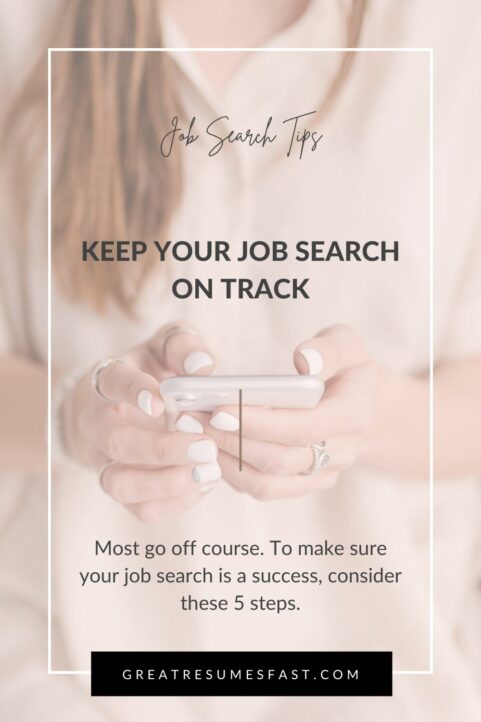Keep Your Job Search On Track
Most go off course. To make sure your job search is a success, consider these 5 steps.
Oh, the list of things you can’t control that can derail a job search! It’s a long one. Is all the rejection starting to feel personal? I get it. From ghosting to bias to unexpected hiring freezes, there are just some things that will throw you off track. But there are others that you have more control over…but which can still derail you, like lack of clarity, neglecting networking, inconsistency, and failure to follow-up. It’s time to take back control and keep your job search on track so you can land your next great role faster. In today’s article, you’ll get a five-step plan to get back on track – and stay on track. Let’s jump in!

Set Specific Career Goals
Without clear goals on the type of role, industry, and company culture you’re targeting, it’s easy to apply to jobs randomly. This scattered focus ends up not only diluting your job search efforts but also causing you to end up with interviews for roles that aren’t a good fit for you.
To avoid this, define your target job, industry, and company culture, and aim for the next several years of your career. These specifics will help guide your job search efforts. They will keep you from applying to jobs that don’t fit the bill and will allow you to focus your time and effort on better-fit opportunities.
Inside the Job Seeker Central Membership, we have several tools you can use to help you get clarity. We have a target company list, an ideal job profile worksheet, and a career roadmap worksheet – all designed to help you get clear on your next steps and where you’re aiming to go next in your career.
Create a Structured Plan
Whether you’re an entry-level job seeker new to the market or in middle management trying to climb the corporate ladder, you need a structured plan for your job search. Otherwise, you end up focusing on some activities more – to the detriment of others – or wasting time on ineffective job search strategies. (I’m looking at those of you who are applying for hundreds of jobs on Indeed or some other job board!)
Combat an inconsistent job search with a structured plan that outlines daily and weekly job search activities.
Below is an example of what a week of job search activities could look like. From this list, you should schedule activities for each day of the week.
JOB SEARCH WEEK 1:
- Create a LAMP list (target employer list of 40 employers, using Steve Dalton’s method from his book The 2-Hour Job Search). (75 minutes)
- Identify two starter contacts for each of your Top Five target companies on your LAMP list. (20 minutes)
- Identify outreach method for 10 starter contacts: LinkedIn InMail, direct email, LinkedIn invitation, or social media. (20 minutes)
- Contact 10 starter contacts with 6-point email requesting an informational meeting, using Steve Dalton’s 6-point email formula from The 2-Hour Job Search. (20 minutes)
- Track your outreach efforts, and note when you emailed the contact. Set a reminder to follow-up in 3 days. (10 minutes)
- Research company and individual for the informational meeting. (15 minutes)
- Informational meeting. (30 minutes)
- Follow-up.(5-10 minutes)
- Informational meeting. (30 minutes)
- Update resume and cover letter. (60 minutes)
The primary focus is on high-ROI job search activities.
One of my favorite pieces of advice to offer job seekers involves practical actions you can take daily that don’t take much time. We all have 5 or 10 minutes a day that we can devote to something that is important to us.
Only have five minutes? Here are five job search activities you can do:
– Like three LinkedIn posts.
– Check a recruiter’s X (formerly Twitter) feed and engage with their tweet.
– Send a thank-you message to a connection.
– Comment on a company’s LinkedIn post, a hiring manager’s post, or a group post.
– Send a connection request on LinkedIn.
Have more time? Here are some 10-minute activities you can do:
– Message a network contact. Tip: Ask a specific question like “I’m considering certification A or B. Which do you recommend?”
– Write a LinkedIn status update. Tip: Offer advice or tips related to your industry or target role.
– Research a target company.
– Introduce yourself to a 2nd-degree connection.
– Find employees from one of your target companies on LinkedIn and connect.
– Turn on Job Alerts. LinkedIn will alert you with daily/weekly alerts via email any time a new job comes up that fits your parameters.
You can sprinkle these into your daily schedule as you have 5-to-10-minute blocks of free time.
The most important point I’m trying to get across is to create daily and weekly routines. Decide how much time you’ll spend researching, applying, networking online, networking offline, and tackling the activities I’ve listed above. Plan out each day’s activities, and write them down. There’s something about being able to check things off a list that helps you feel like you’ve made progress and were productive.
In fact, my favorite method of being productive in my business is using my planner. I have a Michael Hyatt Full Focus Planner, and I absolutely love it because it makes me prioritize my top three tasks for the day – the Big Three things I must get done that day. I know that if I’ve checked off those three things by the end of the day, it was productive, and I’m one step closer to my bigger goals.
You could adapt this same method for your job search. Choose your daily Big Three job search tasks. Prioritize getting them done. A little productivity tip: Do the one you want to do least first. It’s that whole “eat the frog” thing. If you get the one you enjoy least done first, the rest is a piece of cake.
Prioritize quality over quantity. A lot of people don’t network or reach out to hiring managers on LinkedIn because they aren’t sure what to say. Others are intimidated by networking – and still others feel that applying to jobs is a more productive use of their time. I’m going to cover networking more extensively later in this article but it’s important to note that quality trumps quantity. Building relationships leads to more interviews and job offers in the long run.
Cultivate a Strong Network
You can’t neglect networking in your job search.
It’s just that simple. That may not be what you want to hear if you’re an introvert or just plain hate networking. I get it. I’m not a fan of the word networking. It brings up images of me in a room with strangers trying to make god-awful small talk. It’s torture. What helped me was redefining networking.
Networking can be small talk with strangers, and if that’s your thing, more power to you. But if you tend to get all kinds of icky feelings when people mention the word networking, or if the idea of making small talk with strangers makes you want to run in the opposite direction, then I think you’ll like my plan a little better.
One of the things I realized that I really like to do is support other people – support their work, encourage them, and cheer them on. Kindness is right at the top of my personal values list. Being kind comes easy to me and so that’s where I started. I would comment on my colleagues’ posts on LinkedIn, supporting their work and content. If I found a post particularly insightful or helpful I would let the person know. Then, I started doing it consistently with the same people in my industry.
Those online connections turned into friends whom I now chat with over email, see at conferences, and share life updates and compare notes with. I didn’t have to engage in any uncomfortable small talk. I simply supported their work.
When I do go to conferences and meet new people, I’ve found that most often, there are a lot of extroverts at these events. They’ll come up to me and introduce themselves, and then I can answer questions, and ask, “What about you?” It also helps me tremendously to have a couple of scripted, go-to questions already in my mind. That way, there are no awkward silences in our conversations. I’m notorious for being socially awkward, but I know that I have three questions I can fall back on to fill the gaps in the conversation – so I feel less nervous.
I also make a point to never ask for anything outside of advice or information.
So much of the icky feeling from networking comes from asking complete strangers for something – like a referral for a job. Rest easy, my equally socially awkward friend. You will never need to ask a stranger for a job to have a successful job search.
Use networking scripts to help you schedule informational meetings, ask the right questions during meetings, and follow-up afterward. These meetings will be the highest ROI activity you can do in your job search, and you never have to ask for a job. We have networking scripts, guides, and more information on how to work this job search plan inside Job Seeker Central.
Leverage Well-Timed Follow-Up
Failure to follow-up can throw your job search off track quickly. We often don’t think of following up as a job search activity that we must do to be successful in our search. And a lot of job seekers believe that following up consists of sending an email that says:
“Hi, I’m checking on the status of my application.”
This is not proper follow-up. This does absolutely nothing for you.
Every time you follow-up, it’s about positioning and connecting the dots for the employer.
You must show them how you’re the best fit for the role with every single interaction.
When you submit the application on LinkedIn, you should immediately send a note to the hiring manager listed on the job posting. Do NOT send the AI-generated blanket template that LinkedIn recommends. No – you are one step ahead. Send a short note that connects how your experience (1–2 specific points) matches the requirements of the role (1–2 specific requirements).
This is the way you connect the dots for the employer.
You show them exactly how your past experience aligns with the role they have open, and then you ask for an interview. It’s that simple.
After the interview, you follow-up again. Not just with thanks for the interview; mention a point from the interview that you can elaborate on and, again, tie in your experience.
After the informational meeting with that network contact, schedule a time to follow-up three days later.
Review & Adjust Strategy
I regularly see a few other problems that throw job searches off track: resistance to feedback, rejection, and repetition of activities that never deliver results – these can also hold you back.
When you find yourself doing the same job search activities over and over and never getting any results, it’s time to step back, review, and adjust your strategy.
I am a big fan of a test-and-see approach. Test out different methods, activities, and messages. See what works and what doesn’t. If you find a certain message script or resume template gets more traction than another, double down on your efforts.
It’s so easy to feel frustrated, defeated, and overwhelmed in a job search. Rejection feels personal. It’s hard not to be discouraged. On top of that, job searching is a marathon – not a sprint. That’s why it’s important to surround yourself with a support group and get feedback from a coach, career expert, or mentor.
When I created Job Seeker Central, I wanted personalized support to be part of the membership. Each job seeker has a unique background, and getting feedback and insight from an expert can go a long way toward a more successful search. That’s why we include Q&As with a job search coach. It’s also why I started a private LinkedIn support group for members.
Connecting with other job seekers and supporting each other not only expands your network but also helps you stay positive and encouraged during an arduous job search.
Now that you have some strategies in your back pocket to help you keep your job search on track, what about a support group, access to a career coach, and every type of job search tool, resource, script, guide, and course you’ll need to help you get from open-to-work to offer-in-hand?
If this is the type of support you want for your job search, I invite you to become a founding member of Job Seeker Central. The first 100 founding members will get 50% off their membership for as long as they’re a member. Find out more and subscribe here.
Share this post:

About the author
Jessica Hernandez, President, CEO & Founder of Great Resumes Fast
Hi, I’m Jessica. I started this company back in 2008 after more than a decade directing hiring practices at Fortune 500 companies.
What started as a side hustle (before that was even a word!) helping friends of friends with their resumes has now grown into a company that serves hundreds of happy clients a year. But the personal touch? I’ve kept that.
You might have seen me featured as a resume expert in publications like Forbes, Fast Company, and Fortune. And in 2020, I was honored to be named as a LinkedIn Top Voice of the year!
I’m so glad you’re here, and I can’t wait to help you find your next perfect-fit position!
Improve Your Resume: Download Your Free Executive Resume Template Today
Are you struggling to create an executive resume that will impress employers? Download this free executive resume template and receive a series of 10 emails with expert guidance on how to write resume content that resonates with employers so you get more interviews.
It's everything you need to stand out, make an impression, and accelerate your job search.








